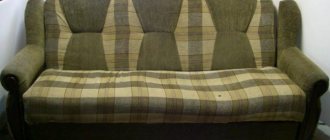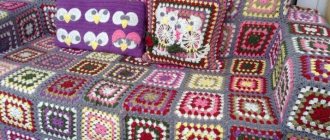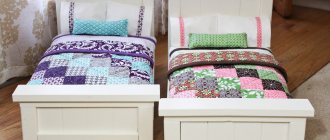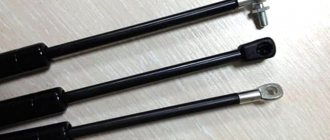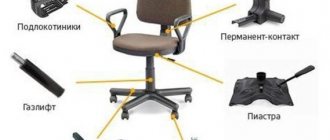Background. In 2003, I bought myself a normal bed with a mattress for the first time. Before that, I slept on a couch, on a homemade “homemade” bed under an ordinary cotton mattress 90 cm wide. But such a personal life... I got tired and took myself a base + a 160x210 mattress + a decorative backrest for the base (it’s actually from a different bed, but it’s on topic).
The mattress was the simplest, dependent springs, jacquard + batting cover, without coconut or latex. But I really liked it. For the first time I lay down on him diagonally, spread my arms... good, nothing was hanging down or resting against me. Just a song!!!
Then everyday life began, the slats broke and the mattress also had a hard time. I changed the slats, then made an “upgrade” to the base (). First my wife and I jumped on the mattress, then the children, it began to lose its appearance and elasticity, and finally, after 13 years of use, it suddenly became clearly uncomfortable to sleep on - some metal objects were stuck into the buttocks
It would be time to change the mattress, but the money would cost about 8, and the children won’t stop jumping around anytime soon...
Okay, I think I’ll take it apart and see. Maybe I’ll repair it, but in the meantime I started calling offices in search of components and looking up the repair procedure on the internet (they mostly gut spring sofas). I was not happy with the components; no one was going to sell me separate springs for repairs. Well, to hell with it, where did ours go? I sent my family away for the weekend and got down to business.
I have a mattress cover with a zipper at the end, but due to the state of the mattress I thought that I would have to cut it to remove or put it on (it looked tight).
But it turned out that everything came off quite easily, slowly, like a stocking.
The design after disassembly looked like this: the base is a block of dependent springs, batting on top/bottom + some kind of fabric like geotextile, filling the groove in the block around the perimeter with thick strips of foam rubber.
From the outside it looked acceptable. From the inside, due to the constant friction of the springs, everything is sprinkled with fine metal dust, which is not rusty.
The block itself was broken in several places.
Firstly, the outer frames of the conventionally upper and lower surfaces, representing rectangles with rounded corners made of approximately 1.5 cm of steel strip, broke in places of spot welding (the mattress had difficulty holding the corresponding shape under load).
Secondly, several springs burst, and just “in the most interesting place,” i.e. in the middle of the lying areas. The broken wire was partially sticking out, which caused my discomfort.
What did I do after cleaning the insulation and washing the foam rubber (by the way, it was very difficult to dry).
First, I connected the perimeter strips using the existing copper sleeves (put it on with tension and slightly flattened it).
I had to tinker with the springs. Since they didn’t sell me spare ones, and I didn’t have a used block to throw away from which I could get serviceable springs on hand, I had to take a simple and not very effective route.
I cut the broken springs to two rings (upper and lower), compressed them in diameter to provide tension in this place of the block, and in this form connected them by bending and winding with the surrounding springs and transverse spiral ties.
The results were flat, but the spring force in the most important place left much to be desired. Since it had to be done at any cost and quickly, I came up with the idea of lining the broken spiral as an additional feature. shock absorber piece of foam rubber. As luck would have it, there was no such piece of foam rubber, and even after running around several stores I couldn’t find any large sponges. Where to go, I took a countless number of small ones, like dishware. I think I'll glue it in a large size.
This is where the fun began. The calculated number of sponges gave such elasticity that while sitting you felt a bump. Through lengthy selection and experimentation, I found the optimal size of pads; it turned out that quite a few of them were needed (so I can open a small hardware store selling dishwashing sponges).
The block became more or less uniform.
The next thing was to push strips of foam rubber around the perimeter of the block and glue the original batting + geotextile on top/bottom with tension.
The glue turned out to be very reactive and addictive, a fake of “Titan” for all kinds of plastic products.
Well, I came to the most intense moment - pulling the cover onto the mattress. I was expecting a catch because of the tight dimensions, but it turned out that everything was easy to put on, especially with the two of us, in the reverse order of removal (the stockings were reversed), they managed it in about 15 leisurely minutes.
The mattress came out well, of course it’s not new, but it will still serve for 2 years, and then you see, the children will calm down or switch to the trampoline, then we’ll take a NEW mattress.
Repairing a spring mattress with your own hands does not look like an impossible task even for an inexperienced craftsman. To repair it yourself you need to follow a number of steps:
1) First, let's disassemble the mattress. In view of the possible accumulation of dust in it, it is better to do this outside, if, of course, there is such an opportunity. Otherwise, you can resort to using a vacuum cleaner.
2) next you need to place the mattress on stools so that it can be approached from any side. Then we remove all the nails, paper clips, outer fabric, soft cushion and thick fabric that insulates the springs.
3) then we proceed to the springs. You need to release them from the mattress frame by cutting off the cord binding. Next you need to set all the springs in a vertical position and check the location of their upper ends. They should be at the same level, approximately 8-10 cm above the frame. Check all springs for wobble and swing - if any, they should be attached to the wooden yard using regular nails.
4) The next stage (when all the mattress springs are attached to the frame) of repairing a spring mattress will be tying the springs. This is done using any strong soft cord, approximately 2-5 centimeters thick. Opposite the rows of springs, you need to hammer in large nails (50-60 mm) and bend them slightly. Next, we perform transverse and longitudinal tension on the belts (cords) prepared earlier.
5) Next you need to check whether the springs are the same length. If so, cover the mattress with lining fabric and secure it around the perimeter with nails. Next, we place a roller made of batting, foam rubber or padding polyester, and attach it to the lining fabric. Well, we wrap the spring mattress on top with decorative fabric!
The repair has been completed!
The store has various types of mattresses. Most often, people make a foam mattress with their own hands using available materials. This option is the most common and convenient. How to make a mattress with your own hands? You can get an economical option (spring, feather), but very acceptable for use.
Is it necessary to increase the firmness of the mattress?
What should a good bed be like: soft or hard? In the time of our grandmothers, it was customary to sleep on feather beds or cotton mattresses. But if you remember the fairy tale, how the princess slept on many feather beds, under which a pea was placed, then it becomes clear why she did not feel well in the morning.
Indeed, lately we have increasingly heard that sleeping on an overly soft surface is not at all healthy and can even harm your health. Doctors talk about the benefits and even the need for sleeping on a hard mattress for a certain category of people. To choose the optimal mattress firmness and buy the mattress that is right for you, you need to focus on many parameters. Take into account your age, weight, health status and even your sleep habits (habitual positions).
So, who is recommended to sleep on a hard mattress:
- Newborns and children up to 2-3 years old. Then the mattress can be changed to medium-hard.
- For teenagers. During periods of rapid growth, the body is subjected to enormous stress. The spine is forming and needs quality support. Therefore, teenagers and young people up to 25 years old need to sleep on mattresses of increased hardness.
- People weighing over 90 kg. If your weight is 50-90 kg, you can choose medium-hard products. With a body weight of less than 50 kg (for an adult), the sleeping place can be soft.
- For athletes and people engaged in heavy physical labor.
- Suffering from spinal diseases.
- For those who like to sleep on their stomach. If the mattress is soft, it will not provide good support to a stomach sleeper and the spine will take an incorrect position. The result is pain, and then unpleasant diagnoses followed by expensive treatment.
Remember the golden rule if you are going to buy a mattress: the higher the weight of the owner, the harder the sleeping surface should be
Installation of plasterboard ceiling
1. At what pitch are the suspensions attached to the ceiling - on the Knauf website I read that the pitch of the main profiles is 1200 mm, the pitch of the suspension is 650 mm. That sheet hangs on two main profiles and supporting bearings adjacent to them (if according to technology, the sheet is along the main ones) and on 6 hangers... Seems to be quite rare - won't it all fall?2. How is the direct suspension attached - with two dowels or one? Again on the Knauf website in the forum info. The department answers that there is one, but in the middle of the suspension there is not a hole, but a slot along which the dowel-nail can slide, and the suspension can warp.3. How to attach an isover to the ceiling?
- 550 replies
Choosing a mattress for back pain
A typical recommendation in case of pain is to use a firmer mattress. This usually provides sufficient support and reduces pain symptoms. However, it is important to avoid self-medication here, since for some diseases the recommendations may be exactly the opposite.
Therefore, first of all, it is necessary to establish the cause of the pain. And who can do this better than a qualified doctor? And only after consultation with a specialist can you choose the right mattress firmness.
Sometimes it is necessary to provide different degrees of support for areas of the body, for example, the lumbar region and the thoracic region. In this case, it is necessary to select or order a model with rigidity zones.
Multi-level ceiling with a bend, a niche and a cornice
Hello to all the specialists!!! Here I found in the wilds of the Internet one ceiling option that I’m crazy about!!! Here it is: I made a tentative drawing based on my room dimensions: B1-B7 - lamps in a circle looking downwards; M1-M3 - lamps in a semi-circle downwards looking P1-P3 - lamps along the line looking down.1) Because According to the drawing, on the left there will be a niche of 15 cm, and the center of the main circle is located in the center of the room, then to eliminate antisymmetry, I made another linear level on the right of 16 cm. How correct will this be from a design point of view? 2) Red, blue and green colors the lines show the trajectories on which the lamps will lie. 3) The dotted black trajectory of the circle shows the eaves side. - And here is the main question:
- 34 replies
A coconut coir mattress cover – will it help?
We have decided on the question of what mattress firmness is best. The next stage is changing the rigidity. Note that the product itself cannot be made more rigid. But increasing the rigidity of the sleeping place with the help of additional means is real. For this purpose, we recommend buying a thin mattress topper, otherwise it is called an orthopedic mattress cover. Such products contain layers of coconut coir (the fibrous part of the nut). Coconut coir is absolutely harmless, hypoallergenic and an environmentally friendly material.
The cost of solving the problem varies from 2.5 to 7 thousand rubles. In any case, it will be cheaper than buying a new mattress. Such a mattress cover, attached to the main mattress, will give the surface additional elasticity and firmness. With its help you can easily adjust the level of hardness of your bed.
In addition to improving orthopedic properties, the coconut mattress cover has many other advantages, namely:
- It is not subject to rotting, does not absorb moisture;
- Does not deform if used correctly;
- Provides optimal air microcirculation in bed;
- Characterized by high strength and reliability;
- It does not harbor pathogenic microorganisms.
Important! Toppers with coconut coir cannot be bent! Otherwise, the natural fibers may break
Step-by-step manufacturing instructions
Now the cover. It is important to use the dimensions of a ready-made piece of foam rubber. It is worth taking seam allowances into account.
If the case has a zipper, you should cut an even larger piece of material in order to successfully embed the zipper.
When you need to make a more rigid option, it is recommended to use felt. This material will protect the foam from rapid penetration of moisture. The felt is dense and natural. It is made from wool. This filler must be placed on the foam rubber on each side in one layer before placing the workpiece in the case.
Another option is to first prepare a cover to match the furniture according to the size of the bed, and then place the material in it. Filling: padding polyester, pieces of holofiber, felt. You can use foam rubber. To prevent the filler from matting, it is advisable to stitch the product with a thick thread.
Special mattress covers
Another option that will help remove excess hardness is a mattress pad. Moreover, it performs two functions at once - it is a good protection of the mattress from dirt and wear, and additionally gives the sleeping area softness and comfort.
For example, a latex mattress cover can take a comfortable position and help your muscles relax - as a result of which after rest you will feel a surge of strength and vigor. In addition, the products have such undoubted advantages as:
- durability;
- environmental friendliness;
- hypoallergenic;
- antibacterial;
- resistance to deformation, shrinkage;
- ensuring an optimal microclimate.
Mattress covers are made from natural or artificial latex. There are no significant differences in properties, but they differ greatly in cost. The height of such mattress covers can vary from 1 to 6 cm. The higher this figure, the higher the anatomical characteristics of the product.
Rivalry is strong
Cotton or foam? Or maybe orthopedic? In terms of market value, the first 2 positions are at the same price level. But orthopedic is beyond competition. To make it you will need foam rubber, the density of which is quite high. You also need a cover. Selecting this material in modern conditions is not difficult.
Cotton has the advantage of being natural. Cotton wool is made from cotton. Although this material has a low density, it is safe for allergy sufferers and asthmatics. But it is better to use synthetic filler if there are no people in the house who are prone to allergies.
Cotton is a priority because of the excellent property of cotton to retain heat longer than its competitors. But cotton wool has a number of disadvantages:
The required density and rigidity by combining several types of material is justified. It is permissible to simultaneously use synthetic holofiber, the density of which is high, or polyurethane.
How to make a mattress with your own hands if you use foam rubber? You will need a good case; you don’t have to buy a ready-made one. You can make it yourself without overpaying. At the same time, it is very convenient to provide the cover with a zipper to create the possibility of washing.
Foam rubber is a material made from a liquid that is poured into a special mold.
Repairing spring mattresses with your own hands at home
Every person needs sleep in the process of life. Health and capacity directly depend on the quality of rest. Most people pay special attention to choosing the appropriate sleep equipment. In this case we are talking about mattresses.
These components provide the necessary rest for the muscles in a horizontal position. However, like any other items, sooner or later components may suffer mechanical damage. At such moments, a logical question arises: how to repair modern spring mattresses.
Devices with continuous weave springs
In this case, we are talking about a standard product, which contains a block with independent springs. Let's consider the main features of such accessories:
- Such an orthopedic mattress has a long service life.
- The load is distributed evenly across all elements.
- Damage to an individual spring does not lead to loss of functionality of the remaining springs.
- There is no standard alignment and fastening.
- The springs are mounted directly to the frame.
- Repairs do not require complete removal of the casing.
- Built-in elements are not very expensive.
- You can repair such a mattress yourself.
As a rule, restoring such a mattress with your own hands involves identifying the fault, gaining access to the problem area, removing the component and installing a new device.
Important. Despite the widespread use of such devices, they quickly lose elasticity under the constant influence of heavy load on a certain area.
Products using springs
Spring models are easy to make. It is worth using purchased springs. It’s easy to choose them by asking the store for special materials for making furniture. If you do everything correctly, you will get an orthopedic mattress with your own hands. Sometimes it is enough to use springs from an old mattress or sofa and make new upholstery. It is recommended to use foam rubber. It’s easier to create an orthopedic mattress with your own hands if you have:
To make your own mattress you will also need twine. They need to tie the springs tightly together. Afterwards, display your structure and place it under the bottom of the slats. Pin. Spring structures add density to the product. Afterwards you need to use filler. Pull the cover on top. Do-it-yourself orthopedic mattress is ready.
So, to make a mattress with your own hands, you don’t need to make a huge effort. But it is important to be able to cut the material by making the correct measurements. The density of the foam rubber needs to be high. Spring designs are also popular, but their manufacture will require more time, skill and material. An orthopedic option that is suitable for any person will be more convenient.
Source
Mattress with independent springs
Here we are talking about an accessory that uses separate components, the operation of which does not depend on each other. Let's look at the main characteristics of the device:
- the presence of a large number of individual elements;
- long service life;
- high degree of compression of components;
- ability to withstand heavy loads;
- easy mattress repair if necessary;
- simple design.
All this makes the demand for such devices quite high, but there is also a high cost of individual elements that may need to be replaced.
Important. In these devices, each independent spring has a certain load life; if it is exceeded, mechanical deformation or breakdown of the product may occur.
Tools needed for repairs
The choice of tool depends on the damage to the mattress. If you need to replace the upholstery, you will need glue and a fabric of suitable size and structure that will not tear after several months of use. If the problem is in the metal structure, you will have to buy new springs to repair the mattress.
Materials and tools that may be needed for repairs:
- Metal wire or elastic cord.
- A backing that can be used with any durable and breathable fabric.
- Wooden slats 70×20 mm.
- Decorative cladding.
- Nails, hammer.
- Furniture stapler.
- Decorative cladding.
- Thread, needle or sewing machine.
- Glue gun.
- Scissors.
- Pliers.
Repairing or restoring a spring mattress for a bed with your own hands involves: removing the upholstery material, replacing the necessary elements, tying the springs and final covering.
Recovery instructions
In order to properly repair the accessory, it is necessary to carry out repair work in accordance with the following step-by-step algorithm:
- All elements must first be cleaned;
- Next, a thorough inspection of the device is performed;
- components are checked for functionality;
- the rack fastening is removed;
- the spring is being knitted or replaced;
- the device is assembled in reverse order;
- The product is re-plated.
In this sequence, restoration work is carried out to repair mattresses that have failed and have ceased to properly perform their functions.
Important. When carrying out restoration activities, special attention should be paid to cleaning, since a number of damages are difficult to trace in the presence of a large accumulation of rust, dust and dirt.
Cleaning and inspection
Checking parts
Rail fastening
This stage includes work to remove the retaining rail to which the damaged spring mechanism is fixed. As a rule, such products are made with special metal latches, due to which they are fixed to the main frame. Here you need to systematically unclip the connections and then remove the latch. Subsequently, after repairing or replacing a component, the rail should be placed in place and secured.
Spring harness
In this case, the old mechanism is restored or a new spring is installed. If an entire unit has become unusable, it is recommended to completely replace it, since restoration will not lead to long-term performance. The spring tying is done using a special device. Afterwards all that remains is to install the product in place, fix and close the mount.
Sheathing
At the final stage, the device is upholstered using new durable and thick fabric. It must be upholstered evenly, starting from the sides. In this case, a construction stapler or furniture nails are used. Here you should make sure that the pointed edges of the clamps are not facing upwards.
Important. When performing repair work yourself, it is recommended to first study the video instructions that are available on the Internet so that you do not encounter difficulties during the work.
How to replace the spring block in a sofa yourself?
Even a modern person may need to replace the springs in his sofa. Especially in a home where there are small children, this problem comes first. They are used to using it as a trampoline for entertainment, and the mechanisms are simply not able to withstand such heavy loads. At such moments, a logical question arises: how to repair springs at home? Don’t worry, using some tips, you can restore your favorite furniture, even of an old format.
Where is the spring block located?
Remember that the spring block of the sofa is located under the upholstery and foam rubber, so getting to it will not be entirely easy. In order to have at least a little idea, you should watch several videos on the Internet about how best to carry out repairs. Be patient, because replacing a spring in a sofa is a very painstaking process.
Step-by-step workflow
The independent spring unit is repaired by completely removing the top cover. On sofas, carefully remove all the staples that hold the upholstery, and then remove it. If desired, you can even replace it, but this procedure is not necessary. Next comes the removal of foam rubber, which, as practice has shown, almost always has different fastenings. In some cases it is simply attached with threads, in others it is glued with special glue. In any case, you will have to remove it, otherwise you will not be able to replace the mechanism.
Replacing the spring block in your sofa will not work without these operations, because most often the failed part tears not only the foam rubber, but even the upholstery. Most often, do-it-yourself sofa repair is done by completely replacing the block. There is no point in restoring one broken part, because, most likely, the rest will also fail in the near future. A complete replacement will ensure comfortable use of upholstered furniture for an even longer period.
What to do if the upholstery bursts?
In general, cracked upholstery can be easily repaired with sewing or patching. In addition, you can put a cover on the damaged surface or throw a beautiful and original blanket. This method will update the decor and keep the surface of the sofa clean. But with a leather sofa there may be some problem. In this case you can use:
- liquid leather to eliminate scratches and tears;
- patches are the same color as the sofa.
A refurbished sofa will be just as comfortable as a new model, so if the upholstery has been badly damaged by use, it is better to simply replace it. To do this, you will need fabric, a stapler and a knife to remove old staples. The main thing is that in this case you can completely rely on your imagination and make a completely new model out of the sofa.
Tips for proper repairs
If you do not know how to fix the spring in your sofa, then you should follow the instructions completely. If one spring has burst, you can carefully pull it out with pliers and screw a new one in place. You will find suitable springs at any hardware store, and if you can’t look for them, secure the gap with a simple wire, and then tie it tightly to the bed. When repairing a spring unit, it is advisable to constantly vacuum the mechanisms themselves and the space around them, since this is where a lot of debris and dust accumulate over a long period of use.
Repairing sofas with replacing springs is very popular among restorers. Old furniture is often restored, so these people approach this issue more professionally. In any case, even beginners repair sofas, so you shouldn’t think that you won’t be able to cope with the problem that has arisen.
Portal about construction
Spring mattress repair
A good quality spring mattress is very comfortable, as it has an orthopedic and anatomical effect. Therefore, such mattresses are very popular and never become outdated.
A good spring mattress usually lasts from 5 to 15 years, depending on operating conditions. When a spring mattress loses its comfortable properties, it must be replaced with a new one. In this case, repairing an old mattress can be an excellent alternative. An innerspring mattress can be easily repaired at home using the tips in this article.
To repair a spring mattress you will need:
- old mattress with springs;
- hammer and nails;
- soft roller (sintepon, foam rubber or batting);
- stapler;
- soft cord;
- decorative upholstery;
- fabric for lining (burlap or tarpaulin);
- slats (7-10 cm wide and 2 cm thick).
1. First you need to disassemble the mattress.
Since a lot of dust accumulates inside the mattress during use, you need to disassemble it very carefully; it is best to do this outside. If this is not possible, you can use a vacuum cleaner.
We turn the mattress over with the decorative upholstery facing down and place it on 4 stools so that it can be freely approached from any side. We take out all the nails and paper clips from it, then remove all the outer fabric and the soft cushion.
The flooring will have to be replaced, so you can immediately throw away the old one. The thick fabric that insulates the springs also needs to be removed and cleaned.
2. After this, you need to inspect the springs and set them all in the correct position. First, we release the springs: we cut off the cord binding from the springs and pull out from the frame all the nails to which it is attached.
We set all springs strictly vertically, with their upper ends at the same level, approximately 8-10 cm above the frame. We fix loose or torn springs by nailing them to the slats and bending nails.
If the mattress springs are attached to the wooden slats using fabric straps, then the straps should be removed and the springs similarly secured using nails.
If instead of slats in the mattress, tensioned fabric belts were used, then they can be secured with wooden slats. To do this, mark the places on the frame where the tapes were, remove the nails and remove the worn belts.
We cut out slats 2 cm thick, 7-10 cm wide and a length equal to the width of the mattress. In the places marked on the frame, we cut out grooves for the slats and nail the slats on each side.
We place the springs in the same way as they were located in the old places, adjust them and nail them, in this case you need to bend both the upper and lower parts of the nail.
3. After all the springs are evenly and firmly attached to the frame, we tie the springs. The top of the springs can be tied with any soft, strong cord 2-5 cm thick.
Opposite the rows of springs, we hammer large nails (approximately 50-60 mm) into the mattress frame two-thirds of the way and bend them slightly. The springs must be tied first in the transverse rows of springs. To do this, we sequentially fasten the outer nails of the row and all the springs of the row using a cord. In this case, it is necessary to ensure that the tension of the cord does not cause the springs to fit too tightly to each other, otherwise they will creak.
When all the transverse rows of springs have been completed, we tie the longitudinal rows in the same way. When tying the longitudinal row, we attach the cord not only to the springs and outer nails, but also to the transverse cord. The last binding is diagonal. We carry it out at an angle of 45° to the transverse and longitudinal strapping. When the tying of the springs is completed, we bend the nails hammered along the edges of the rows completely.
4. Check that all the springs are the same length and cover the mattress with lining fabric, securing it around the perimeter with upholstery nails or using a stapler. We lay the material in a scarf in the corners.
We place a roller made of batting, foam rubber or padding polyester and attach it in several places to the lining fabric. We cover the top of the mattress with decorative fabric, carefully tucking the edges.
Now you know how to repair a spring mattress with your own hands. I hope everything works out for you and you will continue to enjoy a comfortable and healthy sleep on your favorite mattress.
How to extend the life of a mattress
It is clear that one mattress is unlikely to last you a lifetime. Over time, it will still need repairs. But we note that the moment when there is nowhere to go can be delayed for a very decent period. To do this, you need to use this piece of furniture with the utmost care. Try to avoid situations that could damage it.
- You need to buy a mattress according to your weight
- Don't let children jump on the bed\
- Never eat or drink while lying on the bed
- Be sure to let the item dry and ventilate in the fresh air at least once a year.
- The mattress should only be placed in the places intended for it
- To prevent the decorative covering of the mattress from getting dirty, use additional removable covers
If you carefully follow all these simple rules of operation, then your mattress will serve you for many years, and its repair will not be needed very soon. This is a guarantee that your sleep will be healthy and sound.
The article was prepared with the help of specialists from the Sleep Laboratory. Website: https://sleep-lab.ru/ - Online mattress store.
Video. Spring mattress repair
When do you need mattress reupholstery?
Spring frames retain their performance for 8-15 years. The upholstery usually wears out first, and high-quality filling does not require replacement for quite a long time. Most often, repairs are necessary if:
p, blockquote 3,0,0,0,0 —>
- the casing is worn out or damaged;
- springs and other metal parts became deformed or began to bulge;
- the filler has become unusable;
- frame damage has occurred.
What will you have to face?
Of course, there are quite a lot of options for mattress breakdowns and their combinations. But, as a rule, people who start repairs have to face one of the following problems:
- the need to replace upholstery materials;
- damage to the sealing material;
- springs disconnected from the base;
- deformation of spring blocks;
- cracks in the mattress arm.
Usually, the problem is rarely the only one; as a rule, a combination of them is observed. This is especially true for old things that have been repaired many times.
How to reupholster a spring mattress with your own hands
To reupholster a mattress for a bed or sofa, you do not need special skills, knowledge or equipment. The algorithm for replacing the casing is quite simple; you can do it yourself.
Necessary materials
You can reupholster a spring mattress with your own hands using available tools and consumables. If we are only talking about replacing the casing, then you need to prepare:
p, blockquote 7,0,0,0,0 —>
- new fabric for external and internal upholstery;
- working tool - hammer or construction stapler (alternatively);
- fastenings (nails or staples).
p, blockquote 8,0,0,0,0 —>
Depending on the design and any internal damage found, tying cord, foam rubber, wooden slats and serviceable parts may also be useful.
Upholstery removal, inspection
Replacing the mattress upholstery begins with removing the old textile covering. It is recommended that you perform this and subsequent steps not at home, but on the street or in a spacious garage. For convenience, the structure must be placed on the floor or other flat horizontal surface.
p, blockquote 10,0,0,0,0 —>
Next, remove the fasteners holding the worn fabric using any available tool. Most modern models have a decorative zippered cover that is easy to unfasten and remove. If the structure is covered and sewn tightly, then the fabric can be carefully removed by cutting along the seam.
p, blockquote 11,0,0,0,0 —>
p, blockquote 12,1,0,0,0 —>
After removing the upholstery, it is necessary to remove the sealing and cushioning fabric covering the springs. This will ensure that the flexible elements are in good condition.
Cleaning
When reupholstering a spring mattress with your own hands, be sure to clean the structure from any dust accumulated inside. If the restoration is carried out outdoors, then small debris can simply be shaken out. When replacing upholstery in an apartment, you will have to use a vacuum cleaner, removing dust from all corners. Before covering the product, all other parts of the frame also need to be cleaned and wiped.
tight fitting
When there is no need to change the springs, after cleaning all that remains is to re-upholster the mattress. Before doing this, it is important to carefully inspect the structure and make sure that all internal parts are in place. After checking, you can sheathe the frame.
p, blockquote 15,0,0,0,0 —>
To do this, a new cushioning layer and textile covering are laid on the structure, secured in the chosen way. To prevent the material from forming wrinkles, it is enough to lightly pull it with your free hand and secure it with nails or staples.
Materials you will need for work
It is worth taking care to find not only free time to make a mattress, but also to prepare materials for its implementation; before making a mattress with your own hands, you will need certain materials.
You will definitely need a hard foam rubber cover that can be used endlessly. The density of foam rubber for a mattress is a relative indicator. The denser it is, the better. Otherwise, he will quickly wash out.
Such products have a certain classification. There are those that are used only for upholstery. They are soft and porous. Those that are useful for a mattress are elastic, almost non-porous. Soft foam is only suitable for sound insulation.
Polyurethane is often called foam rubber. This is right. If you can find latex-type polyurethane, which is used specifically for upholstery, then you can consider yourself lucky.
This is exactly the material you will need to make your own mattress. Latex-based items are classified as “orthopedic”. So, without overpaying, you can get an excellent, soft substrate. It is known that an orthopedic type model costs a lot of money, especially a branded one.
It is important to choose a particularly durable case. Spring mattresses are the most difficult to make. But it's worth the effort. Given that there is a reliable cover, and felt as protection on all sides, you can get an excellent mattress model without overpaying. After all, branded products are very expensive.
You only need to pay for the materials. For the rest, a person will not spend a penny, but only his efforts. However, you will also need some more details to help make the mattress:
Which spring mattresses are easier to reupholster?
If the internal structure is not damaged, then there will be no difference in how to tighten the spring mattress. Problems arise when additional wear or breakage of frame parts is detected.
p, blockquote 17,0,0,0,0 —>
p, blockquote 18,0,0,1,0 —>
It is much easier to cope with the task of home restoration and covering of mattresses consisting of individual springs. Continuous weaving blocks are assembled only in factory conditions using specialized equipment. It will not be possible to find replacement springs on sale in this design. Only undamaged parts from another old frame can help out.
How to shrink a mattress at home
In some cases, the mattress may need to be altered; for example, its size may not fit the bed, or it may be too high.
When an old foam mattress is not the right size for a new bed, the easiest way to cut it is to cut it
If the product does not have springs, the task is extremely simple - cut the seams and remove unnecessary filler material. Carry out the work as carefully as possible. After removing the excess, sew the seams.
You can easily reduce the size of the mattress yourself. The main thing is to carefully sew up the product.
If springs are present, then to reduce the height you will have to remove the excess spring block.
Where can you reupholster a mattress and is it worth it?
Based on reviews from owners of spring mattresses, we can conclude that a well-repaired product is not inferior in quality to a new one. But sometimes professional frame restoration is needed.
p, blockquote 20,0,0,0,0 —>
There are furniture workshops where spring mattresses are reupholstered. If additional damage is detected, the technicians will perform a comprehensive repair with replacement of individual elements or the entire flexible unit.
p, blockquote 21,0,0,0,0 —>
Prices for dragging depend on the design. At the end of 2022, the approximate cost of work was:
- on a wooden frame - from 2000 rubles;
- on a spring block - from 3000 rubles;
- simple foam rubber - from 2000 rubles;
- on a batting quilt – from 1000 rubles.
p, blockquote 22,0,0,0,0 —>
Although it is possible to reupholster an old-style mattress inexpensively, compared to the cost of a new item, this option turns out to be unprofitable. If we are talking about a premium product that has lost its attractiveness, then restoration provides an opportunity to save money.
p, blockquote 23,0,0,0,0 —>
Regular inspection of the frame allows you to identify the need for repairs. Using the video, you can figure out how to tighten a spring mattress with your own hands. During the detailed master class, the entire process is shown step by step.
p, blockquote 24,0,0,0,1 —>
Sewing a cover
A mandatory attribute of any mattress is a cover. Sewing a mattress cover does not take much time, the technology is simple and straightforward.
Sewing a mattress cover with your own hands is not as difficult as it might seem at first glance. Select the appropriate material and simply follow the instructions.
Materials for work:
Measure the length, width of the mattress, height of the side. You can draw a pattern on a piece of paper. The cover material must completely cover the top and sides. Don't forget to leave 15 cm on each side.
Carefully measure the mattress, not forgetting the required indentations and height of the mattress. This will determine how correctly the cover will sit on the mattress.
Place the fabric on the mattress, carefully folding the corners and secure with a pin. Carefully remove the fabric and machine stitch the corners. On the wrong side, fold the reserved fabric over and sew a hem seam (wide enough to thread the elastic through). Thread an elastic band into the seam. The case is ready.
Sewing a mattress cover takes a little time, but this mattress cover looks no worse than a store-bought one!


